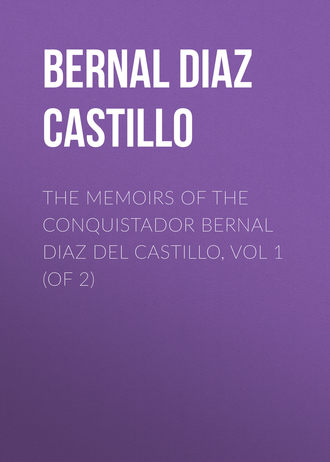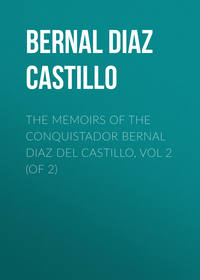 полная версия
полная версияThe Memoirs of the Conquistador Bernal Diaz del Castillo, Vol 1 (of 2)
62
In the large work of Ramusio, entitled 'Raccolta delle Navigazioni e Viaggi,' there is a very interesting account of the city of Mexico. There we find that this market was about three times larger than the one at Salamanca, and surrounded by porticos. Every five days was a great market day, and from forty to fifty thousand people come to buy and sell there. (p. 238.)
63
With regard to Mexican mythology, Bernal Diaz is, perhaps, not quite so correct in general. The abbé F.S. Clavigero, who wrote a history of Mexico, in two volumes quarto, is more intelligent in this respect. (p. 239.)
64
This note refers to the idol, half hidden from view, of which Bernal Diaz has forgotten the name; it was probably the goddess Centeotl, sometimes called Tonacajohua. (p. 240.)
65
The Spanish is, "Estavan malos de bubas ó humores, les dolieron los muslas de baxar!" bubas I have everywhere translated by the general term of swellings in the groin, though it is quite evident, from the 68th letter of Petrus Martyr ab Angleria, (De Rebus Oceanicis el Novo orbe decades tres) that this disease was the syphilis, which was then spreading so dreadfully. (p. 241.)
66
The best-informed writers agree with Bernal Diaz as to the vast extent of this temple. It was so extensive, says Torquemada, that an arrow shot from a crossbow would not reach the length of one of its sides. A few lines lower he says, that each of these sides was three hundred and sixty feet long! The wall which surrounded this huge temple was entirely built of hewn stone. (p. 241.)
67
Bernal Diaz is here speaking of the Mexican picture writing or hieroglyphics. (p. 242.)
68
This passage fully proves the kind disposition of the monarch, for he even overcame his religious scruples to please the very men who came to take his kingdom from him. (p. 244.)
69
The Mexican name of this township was Nauhtlan. (p. 248.)
70
The Mexican name for goddess. (p. 249.)
71
Bernal Diaz only mentions three of these generals by name: Quetzalpopoca, Coatl, and Quiahuitle, which we thought better to insert here. When Quetzalpopoca, says Torquemada, was brought into the presence of the Spaniards, and asked whether he was a vassal of Motecusuma, he replied: "Is it possible in this world to be the vassal of any other monarch." (p. 253.)
72
Alvarado, who sometimes also played a game with Motecusuma, showed little generosity, according to other writers. If he lost, he paid with chalchihuis stones; if he won, he was paid with bars of gold, each worth at least fifty ducats. Motecusuma frequently lost in one evening from forty to fifty of such gold bars to Alvarado; but the more he lost, the more good-humoured he appeared. (p. 258.)
73
A kind of soup or broth, of which the so termed Spanish pepper formed the chief ingredient. (p. 260.)
74
The name of the prince was Cuicuitzcatl. (p. 270.)
75
According to Torquemada, Umbria was only scourged, which appears more probable. (p. 273.)
76
At the present day even this river is known in New Spain by the name of Huasacualco, and even Guacasualco. (p. 274.)
77
For a further account of what happened after the building of this altar, I must refer the reader to the oft-quoted work of Torquemada (Monarchia, Ind. iv, 53.) (p. 286.)
78
This Alonso Mata, as we afterwards see, was met on his way to Mexico by Cortes. (p. 300.)
79
Naborias, Indian servants. (p. 301.)
80
According to Torquemada, Motecusuma, accompanied by a distinguished suite, conducted the Spaniards as far as Iztapalapan. (p. 303.)
81
Probably Topaniqueta, which sounds more like an Indian name. (p. 304.)
82
The real name of this province was Chinantla, but our author calls the inhabitants Chichinatecas. (p. 310.)
83
Hierro is the Spanish word for iron, and Bernal Diaz always uses Hierro for the point of a lance; otherwise one would suppose, – when he says of the Chinantecs, "Hizíeron los hierros muy mas perfetamente," etc., i.e. "they made the irons (points) much more perfect;" – that the working of iron was known in the country long before the arrival of the Spaniards; but it is evident, from what he says four lines below, that these points were made of copper. (p. 311.)
84
Panguenequita, probably another name for Tapanigueta. (p. 311.)
85
Respecting this animal, see note 5, p. 22. (p. 313.)
86
The clater nocturnus. (p. 327.)
87
It need scarcely be remarked that the Spanish guns at that time were fired by means of matches, which were made of hempen tow, boiled in the lees of old wine, and when dry and once lighted they burn on until consumed. (p. 327.)
88
Bernal Diaz has forgotten some circumstances relative to this battle. Three hundred of Narvaez's troops defended themselves bravely for a length of time on one of the temples, nor did they surrender until all their powder was spent. (p. 327.)
89
Of this dreadful disease Gomara says, that it spread from Sempoalla through the whole of New Spain, and that in the greater part of the townships half of the inhabitants were carried off by it. It was a custom among the inhabitants to go immediately from a hot bath into a cold one, so that it was a wonder any escaped death. Those that survived could not help scratching themselves, which naturally left large scars, and rendered them hideous to look at. Torquemada agrees with Gomara, but adds, from the authority of the Indians, that this and other pestilential diseases spread at certain times through the whole of the country; and Bernal Diaz, in describing the person of the younger Xicotencatl, says his face was pitted as if with the smallpox. (p. 332.)
90
A formal inquiry was made into this circumstance, by order of Charles the Fifth. The excellent Bartholomew de las Casas gave judgment, and he pronounced the Mexicans entirely innocent of having had any intention to massacre the troops under Alvarado, but that the latter had massacred the Mexicans without any provocation, merely for the purpose of striking terror among them. In pronouncing this judgment, however, Las Casas may have been carried away by his excessive zeal for humanity towards the Indians. Herrera (Historia de las Indias occidentales, decade ii, b. x,) says: "The fact, however, is, that the Mexicans intended to have murdered all the Spaniards on this occasion; for which purpose they had concealed their arms in the buildings adjoining the temple. This was told the Spaniards by the women, from whom they always learnt the truth." (p. 336.)
91
The daily allowance of a soldier during this time was only fifty grains of maise! (p. 347.)
92
According to other accounts, it certainly appears that Alvarado made this astonishing leap. (Monarchia In., iv, c. 71.) We find that Alvarado was distinguished from his brother by the surname of Alvarado of the leap. Humboldt, in his interesting work on New Spain, has thought it worth his while to rescue the honour of this brave officer with regard to this leap. Even to the present day there is a small bridge near Bonavista, called Salto de Alvarado. (p. 352.)
93
According to other accounts Cortes put great faith in the secret art of this man. It was upon Botello's advice that he also attacked Narvaez in the night time. He had likewise advised the retreat from Mexico in the night time, although he knew, he said, that neither himself, his brother, nor several others of his company would escape alive. (p. 353.)
94
During this retreat three of Motecusuma's sons lost their lives; but there were two other sons of this monarch who survived the fall of their house and became the founders of the distinguished grandee families of Spain, the earls of Montezuma and Tula; one was called Cano and the other Andrada Montezuma. (p. 353.)
95
One circumstance Bernal Diaz has omitted to mention. After the enemy had taken possession of the bridges there were one hundred Spaniards, who, seeing no further chance of making good their retreat, fortified themselves on a teocalli or temple. Here these brave men maintained their position against the whole armed force of the town for three days, but hunger at length compelled them to surrender, and the whole of them were sacrificed to the idols. (p. 353.)
96
The hunger which the Spaniards suffered during these days must have been excessive; for Torquemada states it as a fact, that one of the soldiers had cut out the liver from the body of another and devoured it; for which Cortes was nearly going to hang the man. (p. 354.)
97
Torquemada says, "That the Spaniards stood like a small island in the midst of the ocean, against which the rolling billows beat on every side." When Cortes decided the fate of the day by his courageous attack upon the Mexican commander, the battle had lasted five hours. (p. 354.)
98
The Mexican general's name was Cihuacatzin; he was the Matlaxopilli, commander-in-chief, and carried the imperial standard, called Tlahuizmatlaxopilli, being a golden net ten palms in length. (p. 355.)
99
Bernal Diaz errs here with respect to dates, for the disastrous retreat from Mexico, according to Cortes' despatches and other accounts, took place on the 1st of July, and thus la noche triste (the night of sorrows) was on the night between the 1st and 2d of July, and the battle of Otumpan took place on the 7th. There must either have been some mistake in the original manuscript or in the printing, for the years are also dated erroneously. (p. 356.)
100
This is certainly a corrupted name, for it is dissimilar in sound to all others, and terminates differently. (p. 358.)
101
According to Torquemada, Cortes had left one of his officers, named Juan Perez, with eighty Spaniards in Tlascalla, when he first marched to Mexico. On learning from this officer that Maxixcatzin had offered to march at the head of 100,000 men to his assistance, he grew excessively angry with him, and reproached him in the severest terms for not having accepted of the offer. (p. 359.)
102
Torquemada throws more light on the reason of the younger Xicotencatl's wishing to form an alliance with Mexico. The Mexicans being aware that the Spaniards would derive great advantages by their alliance with Tlascalla, sent an embassy of six distinguished personages to draw this republic into an alliance with them. The matter was formally discussed by the Tlascallan chiefs in council, and though the Mexican ambassadors tried their utmost to persuade them into an alliance, the majority decided against it.
At the head of the minority stood the younger Xicotencatl, and the debate was carried on with such asperity that the young hero, who had more penetration than the rest, was at length forcibly expelled the meeting. (p. 362.)
103
According to Torquemada, these two townships were called Quauhquechulla and Quauhquechola. (p. 368.)
104
Most probably Iztucan. (p. 370.)
105
Cortes, in his despatches, calls this place Izzucan; the same, no doubt, as Iztucan. (p. 372.)


